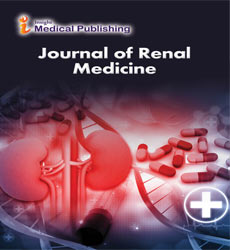Vascular Kidney Pathology and Myeloproliferative Neoplasms
Sarah Cornell*
Department of Internal Medicine, Asahikawa Medical University, Asahikawa, Japan
- *Corresponding Author:
- Sarah Cornell
Department of Internal Medicine,
Asahikawa Medical University, Asahikawa,
Japan,
E-mail: sarah.c213@gmail.com
Received date: December 26, 2023, Manuscript No. IPJRM-24-18593; Editor assigned date: December 29, 2023, PreQC No. IPJRM-24-18593 (PQ); Reviewed date: January 12, 2024, QC No. IPJRM-24-18593; Revised date: January 19, 2024, Manuscript No. IPJRM-24-18593 (R); Published date: January 26, 2024, DOI: 10.36648/ipjrm.7.1.10
Citation: Sarah C (2024) Vascular Kidney Pathology and Myeloproliferative Neoplasms. Jour Ren Med Vol. 7 No.1:10.
Description
Myeloproliferative neoplasms are a heterogeneous gathering of hematological issues including polycythaemia vera, fundamental thrombocythaemia, essential myelofibrosis, and persistent myeloid leukemia. These issues show enormous crossover in hereditary and clinical introduction, and can have various imaging signs. Uncommon apoplexies, embolic occasions all through the fundamental or aspiratory vasculature, or bony discoveries can frequently be signs to the basic infection. There is restricted writing about the imaging highlights of these problems, and this might bring about under-finding. Different medicines are accessible for side effect control, and the advancement of numerous new pharmacological inhibitors has fundamentally further developed horribleness and visualization. Information on these circumstances might empower the radiologist to recommend a MPN as a potential fundamental reason for specific imaging discoveries, especially unexplained splanchnic venous apoplexy, for example without a trace of constant liver infection or pancreatitis. The point of the current survey is to frame utilizing models the various classes of MPN and outline the range of radiological discoveries related with these sicknesses.
Myeloid Leukemia
Raised fringe blood cell counts, like leukocytosis, thrombocytosis, and polycythemia, are in many cases the giving side effect in patients myeloproliferative neoplasms. Since cythemias are vague and may reflect either a responsive or neoplastic cycle, symptomatic workup of these patients is confounded and requires mix of various demonstrative modalities. Cautious morphologic assessment of the smear might give bits of knowledge into the fundamental reason for the strange counts. Notwithstanding, these morphologic discoveries should be deciphered working together with clinical discoveries and other research facility results. Lately, there has been an abundance of new hereditary information in the field of MPN and numerous repetitive changes have been recognized, particularly in cases lacking Philadelphia chromosome. Large numbers of these qualities influence the conclusion as well as guess. Albeit certain changes are specially enhanced in unambiguous MPN types, these transformations are generally not illness characterizing; subsequently, an exhaustive workup ought to constantly incorporate a bone marrow biopsy for morphologic assessment and finding. This survey will portray an exhaustive way to deal with the determination of different MPN, with an accentuation on the demonstrative and prognostic ramifications of repetitive changes in MPN.
Myeloproliferative Neoplasms
Traditional BCR-ABL-negative myeloproliferative neoplasms are a heterogeneous gathering of hematologic malignancies, including fundamental thrombocythemia, polycythemia Vera (PV), and essential myelofibrosis, as well as post-PV-MF and post-ET-MF. Movement to more indicative illness, like unmistakable MF or intense leukemia, addresses one of the significant reasons for dreariness and mortality. There are clinically clear yet additionally subclinical kinds of MPN movement. Clinically clear movement incorporates advancement from Essential Thrombocythemia (ET) to Polycythemia Vera (PV), ET to post-ET-MF, PV to post-PV-MF, or pre-PMF to unmistakable PMF, and change of any of these subtypes to myelodysplastic neoplasms or intense leukemia. Apoplexy, significant discharge, serious diseases, or expanding side effect trouble may proclaim movement. Subclinical sorts of movement might remember increments for the degree of bone marrow fibrosis, increments of driver quality mutational allele trouble, and clonal development. The basic reasons for MPN movement are different and can be ascribed to hereditary changes and ongoing aggravation. Especially, onlooker changes in qualities encoding epigenetic controllers or joining factors were related with movement. At last, comorbidities like foundational aggravation, cardiovascular sicknesses, and organ fibrosis might increase the gamble of movement. The point of this survey was to talk about types and instruments movement and how their insight could further develop risk definition and helpful intercession. Considering these angles, we examine the possible advantages of early conclusion utilizing atomic and practical imaging and exploitable restorative techniques that might forestall movement, yet in addition feature current difficulties and systemic traps.
In the previous 10 years, a few examinations have revealed that patients with persistent myeloproliferative neoplasms have an expanded gamble of second strong malignant growth or lymphoid hematological disease. In this subjective survey study, we present outcomes from concentrates on that report on these malignant growth takes a chance in contrast with disease frequencies in everyone or a benchmark group. For strong tumors, especially dangers of skin malignant growth, cellular breakdown in the lungs, thyroid disease, and kidney malignant growth are raised. The biggest distinction in malignant growth risk between patients and everybody is found in patients under 80 years. Disease guess is adversely impacted because of cardiovascular occasions, apoplexy, and contaminations by a simultaneous MPN finding principally among patients with confined malignant growth. Our audit underscores that clinicians really focusing on patients with MPNs ought to know about the very irrefutable expanded hazard of second nonmyeloid malignant growths.
Open Access Journals
- Aquaculture & Veterinary Science
- Chemistry & Chemical Sciences
- Clinical Sciences
- Engineering
- General Science
- Genetics & Molecular Biology
- Health Care & Nursing
- Immunology & Microbiology
- Materials Science
- Mathematics & Physics
- Medical Sciences
- Neurology & Psychiatry
- Oncology & Cancer Science
- Pharmaceutical Sciences
